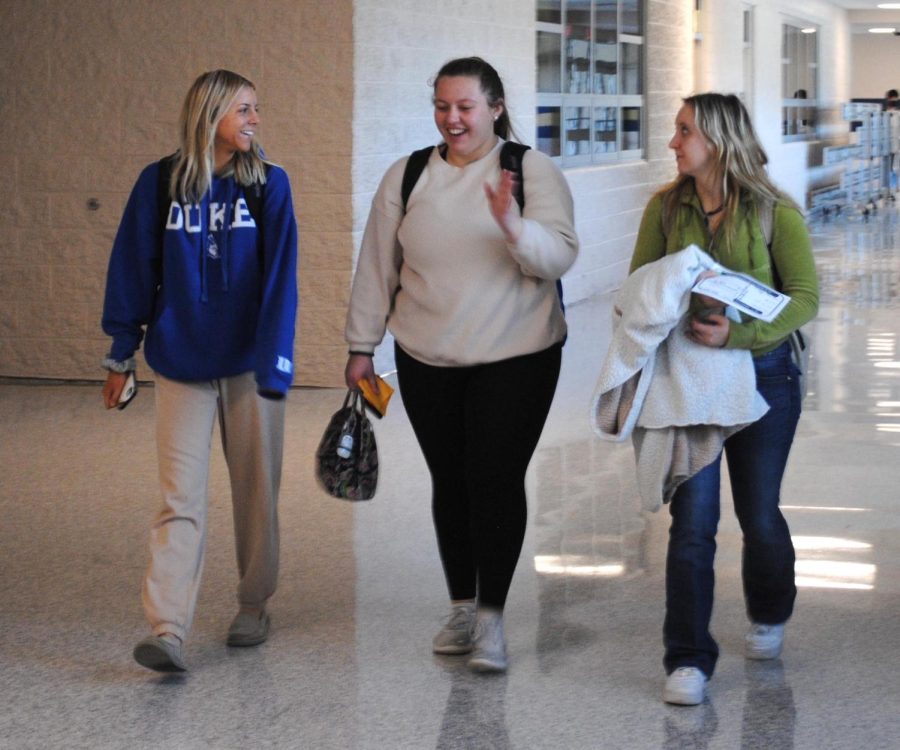Building Confidence
The effects of 18 months virtually loom as students adjust to life back on the high school campus.
From left, Sammy Vickery, Amy Prophet, and Ally Frink walk down the art studio hallway in the 10-12 Center in March.
April 8, 2022
More than 100 days into the 2021-2022 school year, many students are overall happier to return to in-person learning.
“I moved schools, but also COVID really kind of limited my chances to make more friends,” said ninth-grader Ashley Coleman. “I really like this school year, I met tons of new people and I’m really happy about that.”
There is no doubt that the world is beginning to return to some sense of normalcy as the Spring-Ford Area School District loosened masking mandates just this past month. With this, it is important to reflect on the influence that 18 months of learning at home virtually had on students and how those experiences will affect their learning now and in the future.
Reopening schools five days a week this fall thankfully meant there were many new starts for students, but the effects of learning full-time at home remained.
Kids grew comfortable with the nuances of at-home learning; they could eat whenever they wanted, so now they wanted meals more often. Furthermore, they used Chromebooks, so writing on paper sometimes proved difficult. These examples all demonstrate that it truly is the little things that have changed the most.
“Yeah, I think this year has been weird, and I definitely liked being home better,” said ninth-grader Jack Miscavage who learned virtually last year. “I could eat and do whatever I wanted, whenever I wanted, and that was pretty nice.”
Overcoming these changes to learning affected students, parents, and teachers.
An increased workload was something teachers faced during the pandemic. It is easy to see that teachers were presented with a great deal more than their typical workload, balancing in-person and virtual learning. Teachers had to learn how to navigate several different platforms, change their curriculum to fit online learning, and battle the challenge of unmotivated students.
As students returned to pencil and paper learning, hopefully some teacher and student stress is relieved.
The return to in-person learning, though, is a breeding ground for stress in and of itself. Students are now faced with the challenges of testing, midterms, and seven-hour school days once again.
For students that had been home and doing school from their bedrooms since March of 2020, in-person learning was a huge leap from virtual. The stress of post-pandemic learning, now more than ever, could affect students’ mental and emotional health, though many students undoubtedly suffered from poor mental health as an effect of online schooling.
One overwhelming positive out of the return to in-person is social interaction. As students returned, they were finally able to connect once again. Sports and extracurriculars are back in session, and students now have more opportunities to flourish and prepare themselves for the real world.
“Learning at home was pretty weird for me, I hated not getting to see my friends every day,” ninth-grader Emma Hokanson said. “I feel like I have a lot more fun at school when I get to talk and be around people.”
Social interaction is so important for people of any age, but especially students. The opportunities to grow as a person with peers proved truly difficult in an on-line environment.
“School is not just a place where (students) learn academics,” said Julie Hubbard, a University of Delaware professor, in an article on WHYY.org last spring. “It’s how they learn to get along with other kids their same age — how to navigate and negotiate all that.”
Sports and clubs have once again allowed for school to not only be a place to learn, but a place that students look forward to going to each day for events beyond academics. This may in fact be the most positive thing to come out of post-pandemic learning for students — because isn’t having a good time while learning what we need to create the balance that everyone wants?

